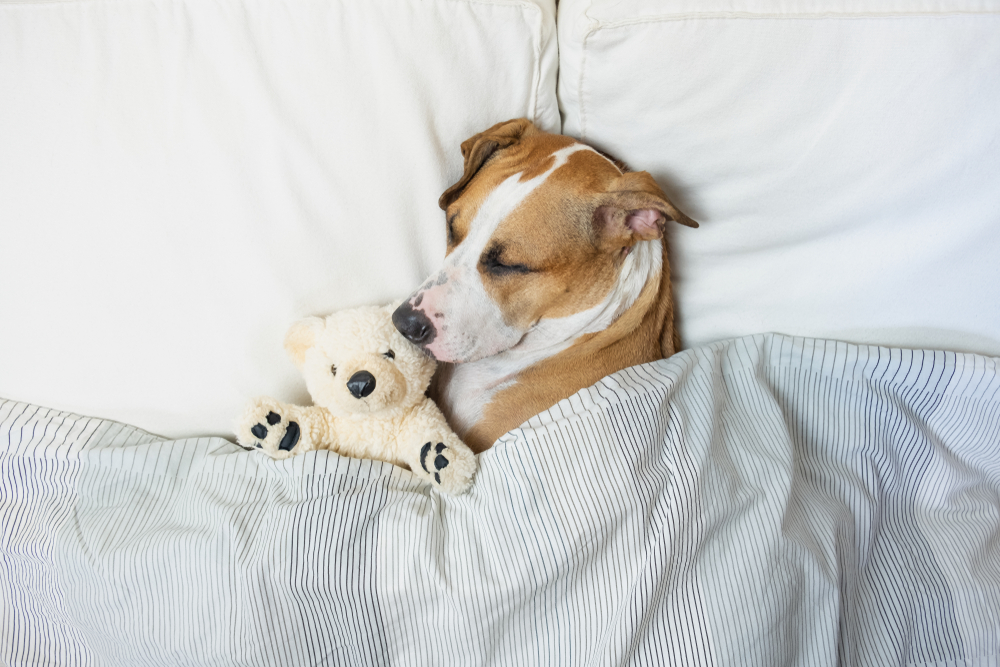From teeth falling out to being chased down a dark alleyway – or something decidedly more bizarre – we humans are no strangers to disturbing nightmares. But what about our furry friends? Do dogs have nightmares too?
Let’s find out!
Do dogs have nightmares?
Before we get down to nightmares, do dogs even dream? As it turns out, they do! In fact, experts believe that the majority of vertebrate creatures (that is, those that have a backbone) dream.
You see, it’s all to do with dogs’ sleep cycles. Scientists have conducted several experiments around animals and dreaming, including on dogs. They’ve found that dogs go through the same sleep cycles that we do: bursts of wakefulness, then rapid eye movement (REM) sleep, then non-REM sleep. REM sleep is a very deep slumber, and it’s where dreams happen. Much research supports the idea that dogs dream during the REM phase, like humans do.
The difference between humans and dogs, though, is that dogs’ sleep cycles are shorter. We go through 4-5 cycles per night, with each one lasting around 90 minutes. Dogs will usually go through 20 cycles in a night, with each one only lasting 15 or so minutes.
So if they can indeed dream, do dogs have nightmares, too? Yes! Not all dreams are pleasant ones, and unfortunately, dogs are prone to the same kinds of night terrors as humans.
How can I tell if my dog is having a nightmare?
Trying to figure out whether your doggo is dreaming of something lovely or loathsome? The behavioural differences between the two are subtle, but there are a few tell-tale signs to look out for. If a dog is dreaming, they’ll usually exhibit the following behaviours:
- Rapid eye movement under their closed eyelids (yep, it’s not called REM sleep for nothing!)
- Very gentle movements like running, digging, or twitching (this indicates they could be dreaming of a trip to the dog park with their favourite local Dog Walker!)
- Brief, quiet vocalisations, such as groaning, whining, or barking
On the other hand, if your dog is having a nightmare, you may notice the following:
- The same rapid eye movement as when they’re dreaming
- More intense noises, including growling, snarling, barking, howling, or whimpering
- More extreme movements of their limbs
- Changes in breathing patterns, such as rapid or heavy breathing, or holding their breath
- Waking up suddenly, as if in fright
Do dogs have nightmares for the same reasons humans do?
Well, kind of. In both humans and dogs, the underlying cause of nightmares is usually some form of stress or anxiety.
However, the root of that stress or anxiety can be very different. Among humans, nightmares might be generated by day-to-day stresses like work or money. Or, they could be caused by something bigger like the loss of a loved one or an upcoming major change that’s making someone nervous.
That last one is important; while humans can get stressed over something that hasn’t happened yet, dogs tend to have nightmares over an experience that’s already occurred. Most of the time, it’s anxiety over a particular situation or some kind of trauma.
Dogs may fear going to the groomers to get their fur trimmed, or perhaps they’re nervous around a certain person. In more extreme cases, a stressed dog may have experienced abuse in the past that’s causing them to have nightmares.
Should I wake my dog from their nightmare?
If you suspect your pooch is having a nightmare, you’re usually best leaving them to it – even if it appears that they’re in a state of distress. This is because waking them suddenly can scare them and cause them to lash out or possibly even bite. Plus, given how short each sleep cycle lasts among dogs, the nightmare will likely be over in a short time, anyway.
If you want to wake them up for whatever reason, make sure you do so gently. Using a soothing voice to softly rouse your pupper is a better option than patting or shaking them – not least because it minimises the chance of getting bitten!
Are nightmares bad for dogs?
Nightmares themselves aren’t particularly bad for dogs, unless they become very frequent. Because they’re rooted in anxiety or trauma, regular nightmares can perpetuate existing stresses for your dog. Luckily, you can help alleviate their fears using a few tactics.
How can I help my dog with their nightmares?
Help your pooch to overcome their fears
If your dog is scared of something in particular, slowly exposing them to their fear can help them overcome it. This technique is called desensitisation. To perform desensitisation, you just need to gradually raise the level of exposure at each interval, in a safe environment.
Here’s how that would look if your dog is scared of going to the grooming salon. The first time you expose your pupper, you could show them the fur trimmer at home, where they feel comfortable. Next, you could trim a small patch of fur before letting them go – again, in a safe environment such as your home. Build your way up until eventually your dog is comfortable going to the groomers for a full cut.
You can also use treats or pats in conjunction with desensitisation. This is so that your dog starts to build a more positive association with whatever scares them. This technique is called counter-conditioning.
If you need assistance with healing your doggo’s emotional trauma, you can always ask your vet for advice. As well, a professional dog trainer can help with things like desensitisation, counter-conditioning, and other training techniques.
Provide a calming environment
Ensuring your dog has a safe and comfortable place to sleep can help minimise the chance of them experiencing nightmares. If they can’t sleep in your bed, a cosy dog bed or crate in a warm (but not too warm) spot is ideal.
You can also try to relax your pooch as they drift off by playing quiet, calming music. Alternatively, pressure wraps and pheromone-releasing collars are popular tools for soothing dogs.
Monitor for signs of a seizure
In very rare cases, the signs that your dog is dreaming may indicate a seizure. While dreaming and nightmare behaviours are gentle and quick (lasting only 30 seconds or so), the movements associated with seizure are different.
If your dog is having a seizure, their dog’s limbs may go stiff and their movements might be more aggressive. They may also drool, or urinate or defecate themselves. And lastly, you’ll probably find it hard to wake them up. If they’re merely dreaming, though, you can usually rouse them quite easily.
If you suspect your dog has had a seizure, get them to the vet right away for an assessment.


